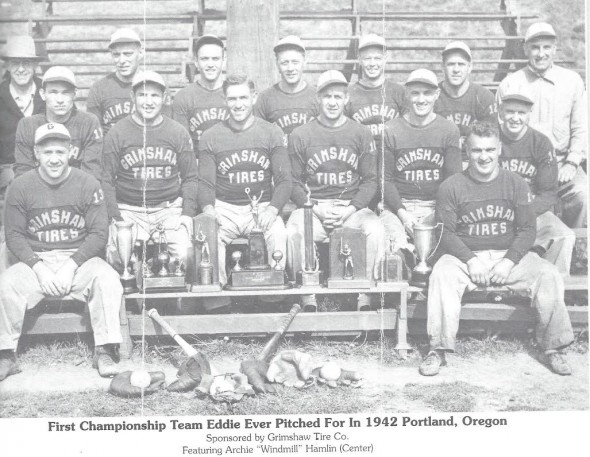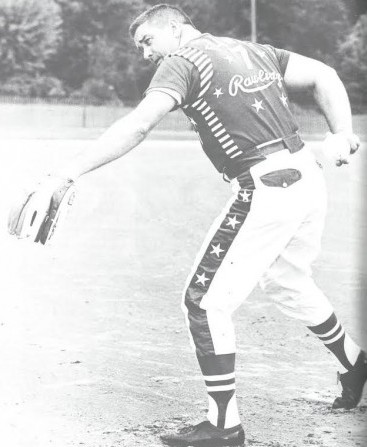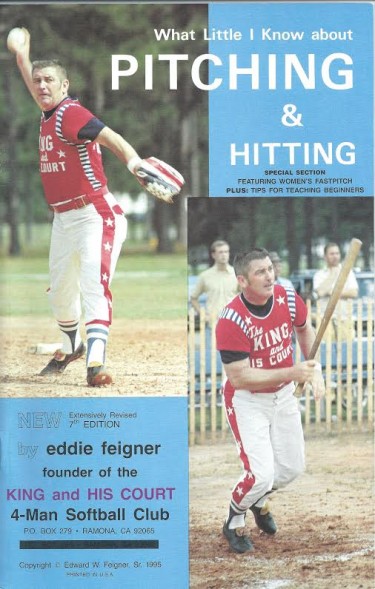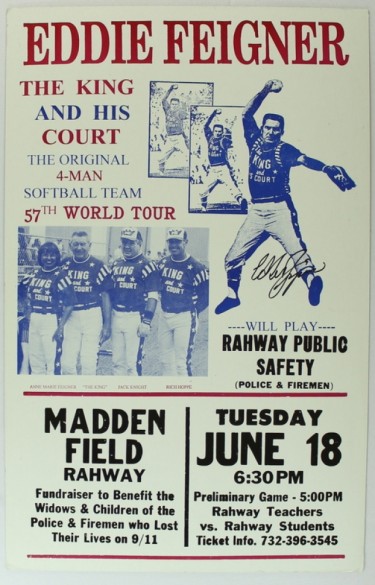
By David Eskenazi and Steve Rudman
Not long after Eddie Feigner experienced an emotional reunion with a mother who abandoned him at birth, he began pitching recreational softball in Walla Walla, WA. ,for Kilburg’s Grocery of the Green Pea League. The year: 1946. One day – Feigner never could recall the date — his team obliterated a club from Pendleton, OR., 33-0, after which players from both squads repaired to a watering hole, where the Pendleton manager, seething at the day’s humiliation, tossed a snide remark in Feigner’s direction.
An angry Feigner shot back, “You’re so pitiful, I could lick you with my catcher.”
“Put up or shut up,” the manager replied.
“I’ll need four guys on my side to bat,” Feigner said, “and you’ll be sorry. I’d play you with two, but you’d walk us both.”

Far as we can tell, the grudge rematch never happened. But Feigner, intrigued by the concept he’d proposed, selected three players – a catcher, first baseman and shortstop – that he’d known since fourth grade and scheduled a game against a nine-man contingent of convicts on a field inside the Walla Walla state pen. As he became famous for doing, Feigner threw a perfect game and struck out every batter except two — one who got his bat on the ball with a sneak bunt, the other who slapped a grounder to first.
After Feigner’s four-man team routed the convicts 7-0, regional newspapers picked up the story and spread it throughout the Pacific Northwest. Soon came challenges from practically every town and city in the state and, before long, “The King (Feigner) and His Court” were on their way.
While Feigner worked to conjure up what newspapers of the day described as “gimmick games,” he pitched – seriously — in a variety of men’s leagues, including for the 1947 Skyroom Flyers in Seattle’s Double A League. He also pitched for the Glendale White Center Athletic Club and won a state championship.
The King and His Court barnstormed for 55 years, Feigner ultimately achieving fame as the greatest softball pitcher who ever lived. At his peak, in the 1950s and 1960s, he threw a softball harder than any major league pitcher ever threw a baseball. His fastball was officially timed at 104 mph and unofficially at 114. At the time of Feigner’s death – Feb. 9, 2007 – the fastest documented pitch thrown by a major leaguer was 104.8 mph (Joel Zumaya of the Detroit Tigers in a playoff game Oct. 10, 2006).
Feigner pitched hundreds of games each year against local all-star teams. He pitched on military bases and rifle ranges, in rodeo arenas, on cow pastures and parking lots. He pitched in cemeteries, and on airplane runways. He pitched in almost all major and minor league parks, including Yankee Stadium. He even pitched on the Great Wall of China.
Feigner not only threw more than 1,000 doubleheaders, he tossed more than 200 tripleheaders. By the time he retired, Feigner had pitched in all 50 states and 98 countries.
In a 1964 exhibition at Dodger Stadium, Feigner faced a lineup of six major league players, five of whom were later elected to the Baseball Hall of Fame. Feigner struck out all six — Willie Mays, Roberto Clemente, Brooks Robinson, Willie McCovey, Maury Wills and Harmon Killebrew — in succession.
Feigner kept meticulous records, documenting 9,743 wins, 141,517 strikeouts, 930 no-hitters, 238 perfect games and 1,500-plus shutouts in more than 10,000 games – staggering numbers that he achieved with 19 windups, 14 types of deliveries and five speeds. An excellent hitter, Feigner also claimed to have slugged 83 home runs in a 250-game exhibition season, and no one ever disputed his statistics.

Feigner created lasting impressions with his pitching stunts. According to The Washington Post, which published an extensive profile following his death, Feigner could strike out players while blindfolded (8,698 times) or while pitching behind his back or between his legs. He used a curveball that dipped 18 inches. To give his opponents a chance, he often pitched from second base or, on occasion, from center field. He even pitched from his knees.
One batter who faced Feigner described the experience to The Orlando Sentinel: “I was waiting for a pitch, heard a noise, watched the catcher throw the ball back. It was incredible. There was no way to get the bat off my shoulder before the ball got there. I don’t know how anybody ever hit the guy.”
“You could never hit him,” Roy Thurman told Pendleton’s East Oregonian. Thurman played city-league ball against the King and His Court during the team’s early days. “He’d pitch from second base on his knees and strike you out, and he’d pitch from center field blindfolded.”
Feigner often appeared on television, including “The Today Show,” “I’ve Got a Secret,” “What’s My Line?” and “CBS Sports Spectacular.” On “The Tonight Show,” he knocked a cigar out of Johnny Carson’s mouth throwing blindfolded. Sports Illustrated once called Feigner “the last true American barnstormer and the most underrated athlete of his time,” but Feigner didn’t entirely accept the endorsement.

“I’m a pipsqueak because I’m caught up in a nothing game,” Feigner told the magazine in 1972. “It’s like being a world-champion noseblower.”
Still, Feigner pleased fans and baffled batters everywhere. During the 1981 major league strike, in front of 16,000 at the Silverdome in Pontiac, MI., Feigner and his Court beat a nine-man team that included several major league players. He was 56 at the time.
“I am the world’s finest softball pitcher by at least 100%,” Feigner told Sports Illustrated without exaggeration. “I can say this because I have never met or seen anybody who was anywhere near half as good as me. I have perfect control. I throw the best changeup there ever was. I throw other pitches nobody can. My in-drop and in-raise are super pitches and unique. Anyone can throw the out-drop or out-raise, but everywhere I travel pitchers ask me how to throw the others.
“Who else pitches blindfolded? Who else pitches from second base? I used to throw strikes from center field. I struck out a batter from center once. We figured that would never happen again, so we took it out of the show. Who else pitches from behind his back or between his legs? For strikes? My fastball was clocked at 104 mph. Check Koufax. Check Feller. I’m the fastest. There have been only three or four arms like mine ever in history. I once struck out a man on one pitch; he swung and missed three times at the same changeup.”
“On the field, he was a master showman, a brilliant pitcher, and the creator of the most popular softball attraction in history,” longtime friend and teammate Jack Knight told The Associated Press. “And off the field, he was one tough son of a gun. He was a former Marine, and everything was by the numbers. He made millions, and was generous to a fault.”
Eddie Feigner was born March 25, 1925 in Walla Walla, soon became separated from his unwed mother, and was adopted by a woman named Mary King, who had already raised four sons after her husband deserted her during the Great Depression. Mary King christened the new arrival Mryle Vernon King and reared him as a staunch Seventh Day Adventist.

For reasons that require footnotes, which we eschew, Seventh Day Adventists didn’t play baseball, so King took up softball as a grade schooler. But classmates, balking at his religion, refused to let him into their games. So King learned how to pitch on his own. He hooked up with a young boy named Meade Kinzer, and they became so good at pitch and catch that they were eventually invited to participate in organized games.
By the time Mryle King reached junior high school, he had become the best pitcher for the local college team. And by the time he was 16, he was throwing in Walla Walla men’s leagues six nights a week. Mryle King was so good that one of the leagues banned him from the mound.
Walla Walla Academy, run by Seventh Day Adventists, kicked Mryle King out of school after he peppered the building with rocks for reasons unknown. That’s when Myrle King became a professional roustabout, mainly drifting between Seattle and Portland. He supported himself as a dock worker, crane operator, ditch digger, streetcar conductor, vegetable and prune picker, gas station attendant, stand-up comedian, and paid tenor at funerals. Mryle King even became a gourmet chef while working at a bar and grill at the Portland airport.
None of that made Mryle King happy so, in 1942, he enlisted in the Marines. That didn’t make him any happier. He suffered two nervous breakdowns, got married and divorced twice and tried several times to slash his wrists. The Marines finally threw him in the “X Ward.” Mryle King called it the “rubber room.”
“The X Ward was a place for wackos, and I belonged,” the future softball whiz told Sports Illustrated. “I was wacky and wanted to die. I was a pitiful, screwed-up person with no home, no father and no real mother I knew about. I was also an uncouth, uneducated, arrogant, belligerent, no-good, miserable excuse for a human being. I was bent on destroying myself. A psychiatrist told me I’d never straighten up until I found my mother. When I did, it completely changed my life.”
The pitcher found her Dec. 16, 1945 after a long search that began at the Walla Walla Municipal Hall of Records. Turned out, the former Naomi Feigner had not only been living in Walla Walla, she had periodically hired Myrle King to perform odd jobs around her home without recognizing he was her son.
The reunion turned around Mryle King’s life. The very week he met his mother, he changed his name to Eddie Feigner – Eddie in honor of an orphan named Eddie Colts, who had been one of Eddie’s best friends until he died in a knife fight — and Naomi Feigner.

“Being Myrle King was a disgraceful, sleazy existence, and I wanted it over. I loved Mrs. King, but I was so sick of life as her son. If I had it to do over, I wouldn’t have moved in with my real mother. I would have gone back to see Mrs. King more. She started to die right then. I think I broke her heart.”
Not long after the reunion, Eddie Feigner started “The King and His Court.” At first, the team played two-inning exhibitions prior to regular baseball and softball games, but the warm-up act proved so popular that more fans began attending than games that counted.
Feigner and his Court developed into a regional phenomenon over the next four years, rarely traveling east of Idaho. But despite their popularity, Feigner and his Court never made livable wages and, by 1950, found themselves at a crossroads: either abandon the show or take it national to see if that improved the bottom line.
Feigner mailed 3,000 letters to a hodgepodge of service organizations, community groups and advertisers – anybody who might want to sponsor a game. But the letter campaign failed. Undeterred, Feigner and the Court struck out for the South in a pair of station wagons, receiving a nasty surprise when they arrived in El Paso, TX. There, the Amateur Softball Association of America had banned its members – all teams, all players – from playing against Feigner and the Court out of fear of embarrassment.
But Feigner eventually rustled up some games, essentially after “auditioning” the Court’s act and showing local promoters what it could do. Slowly but surely, the tour gained traction. Over a two-night stand in St. Petersburg, FL, Feigner and his Court drew 4,000 fans to Al Lang Field, and one of the attendees was a promoter working on behalf of the annual Canadian National Exhibition, slated in 1950 for Toronto. Feigner and the Court played there for eight days, drawing huge crowds. Two games, a scoreless tie and a 1-0 win over the Tip Top Tailors, then the world softball champions, not only attracted enormous publicity, but legitimized Feigner and his Court.
By 1955, Feigner and his Court were turning a profit. By 1964, they started receiving TV gigs, including an appearance on CBSSports Spectacular, and by the mid-1970s they all made comfortable livings even though they only worked half the year. Ultimately, Feigner and the Court played in front of more than 11 million people.

Feigner made two notable appearances in Seattle during the height of the Court’s popularity, the first against Pay ‘n Pak, the defending Pacific Northwest regional fast pitch champions, June 14, 1972 at Sick’s Stadium. The game drew 8,000 fans, who watched Pay ‘n Pak tag Feigner with one of his rare defeats, 7-0.
“But the score couldn’t have mattered less,” Jack McLavey wrote in The Seattle Times. “The Fans came to see what Feigner could do. Some of the things he did was strike out two batters while wearing a blindfold, another while pitching from second base and another with a fantastic triple windup.”
Feigner and the Court arranged for a June 14, 1973 rematch with Pay ‘n Pak at White Center Stadium. In front of 2,000, Feigner and the Court won 5-3 with Feigner fanning 12, including four while pitching between his legs and two more blindfolded from second base.
While Feigner and his Court became softball’s equivalent of the Harlem Globetrotters, there was one key difference. The teams Feigner and his Court played routinely failed to cooperate with stunts and comedic interruptions.
“It’s easy for the Globetrotters because the other team plays along,” Feigner told Sports Illustrated. “But we get teams who don’t care about the people in the stands, the show, the money or anything. They just want to beat us our ass. They actually think the crowd came to see them.”
In one of Feigner’s most popular, Globetrotter-style acts, he launched into a triple windup. Simultaneously, his catcher stood up to obscure the umpire’s vision. Instead of throwing to his catcher, Feigner slammed the ball into his own mitt, creating a loud smack. A tick of the clock later, the catcher slammed his fist into his own mitt, creating another loud smack, as though he’d caught the ball.
Feigner loved to tell stories about how many times umpires called his phantom pitches for strikes rather than admit they didn’t see them. Feigner particularly favored a story about a game in Edmonton when a batter argued that one of Feigner’s non-pitches was high.
Feigner suffered a stroke in 2000, the year he was inducted into the National Senior Softball Hall of Fame and one day after he threw out the first pitch before the women’s softball competition at the Sydney Olympics. That ended his playing/performing career at age 75. Feigner retired to Trenton, TN., for several years and then relocated to Huntsville, AL, where he died Feb. 9, 2007, from a respiratory ailment related to dementia. He was 81.

Feigner never shied away from tooting his horn. He once told The New York Times, “It’s a good feeling to know that I am the only one of my kind in the history of the world.”
He told Sports Illustrated, “If I was this good in golf I could buy and sell Arnold Palmer. Arnold Palmer! That would be nice. But I’m not singing the blues. Hearing a woman and a child say, ‘I love you’ is worth more than any number of those fickle fans who drop you in a moment.”
And this: “If I ever bear down, the teams we play don’t have a chance in hell. I have to play with a four-man team. If I got nine together, the game would be a farce. Four men, remember. Four men against nine. And we win nine times out of 10. Amazing. It really is. One of the newspaper boys said it best many years ago. He said Feigner could play with the plumber, the maid and grease monkey and still win. My arm never ceases to amaze even me.”
“I’m proud to be a friend of Joe Namath and Andy Williams and Glen Campbell and the rest of that new breed,” he also told The Times. “A guy asked me if I ever pitched against Sinatra. ‘Frank?’ I said. ‘Sure, I pitched against Frank, and Deano, too, and Sammy Davis.’ But that’s enough. People in my own sport know who I am. It’s enough to entertain those kids up in the stands and maybe do something they’ll remember.”
Had Feigner played a higher-profile sport, he would have been a sporting legend known far and wide. Because he didn’t, few remember him today, although he received a belated accolade recently when he was posthumously inducted into the State of Washington Sports Hall of Fame during a ceremony at Safeco Field.
“I don’t need monuments built to me,” Feigner told SI in 1976. “God willing, if I die, I bet I don’t get a 10-second blurb on the national media. That doesn’t bother me in the least. You know all I want? If you believe in the Bible, you earn a crown of stars when you get to heaven. The stars are for the people you made happy and the people you helped get to heaven. If I earn just one star I’ll be a happy man.”
—————————————-
Many of the historic images published on Sportspress Northwest are provided by resident Northwest sports history aficionado David Eskenazi. Check out David’s Wayback Machine Archive. David can be reached at (206) 441-1900, or at seattlesportshistory@gmail.com

2 Comments
Great piece, guys. I never had the chance to see Feigner pitch but I DID follow that Pay’n’Pak team closely over the years and they were (by far) the best fastpitch team in the Northwest with guys like Butch Batt, Dick Christenson (who topped 100 MPH himself) and the Nokes brothers. Beating that crew in 1973 with just three other players was a feat.
There’ll never be another Eddie Feigner. When he died, barnstorming went with him. He WAS a true phenomenon…he’d tell you himself.
Great subject, great research. great writing. Thanks. Brought a grin and nod to my morning.